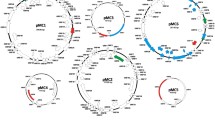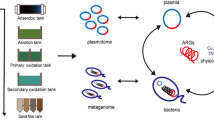Abstract
On-farm biopurification systems (BPSs) represent an efficient technology for treating pesticide-contaminated wastewater. Biodegradation by genetically adapted bacteria has been suggested to perform a major contribution to the removal of pesticides in BPSs. Recently, several studies pointed to the role of IncP-1 plasmids in the degradation of pesticides in BPSs but this was never linked with catabolic markers. Therefore, a microcosm experiment was conducted in order to examine whether changes in mobile genetic element (MGE) abundances in response to the application of phenylurea herbicide linuron are linked with changes in catabolic genes. Denaturing gradient gel electrophoresis (DGGE) fingerprints of 16S ribosomal RNA gene fragments amplified from total community (TC)-DNA suggested significant shifts in the bacterial community composition. PCR-Southern blot-based detection of genes involved in linuron hydrolysis (libA and hylA) or degradation of its metabolite 3,4-dichloroaniline (dcaQ I , dcaQ II , and ccdC) in TC-DNA showed that the abundance of the hylA gene was increased faster and stronger in response to linuron application than that of the libA gene, and that the dcaQ II gene was more abundant than the isofunctional gene dcaQ I 20 and 60 days after linuron addition. Furthermore, a significant increase in the relative abundance of the IncP-1-specific korB gene in response to linuron was recorded. Our data suggest that different bacterial populations bearing isofunctional genes coding for enzymes degrading linuron seemed to be enriched in BPSs in response to linuron and that IncP-1 plasmids might be involved in their dissemination.




Similar content being viewed by others
References
Bergmark L, Poulsen PH, Al-Soud WA, Norman A, Hansen LH, Sørensen SJ (2012) Assessment of the specificity of Burkholderia and Pseudomonas qPCR assays for detection of these genera in soil using 454 pyrosequencing. FEMS Microbiol Lett 333:77–84. doi:10.1111/j.1574-6968.2012.02601.x
Bers K, Batisson I, Proost P, Wattiez R, De Mot R, Springael D (2013) HylA, an alternative hydrolase for initiation of catabolism of the phenylurea herbicide linuron in Variovorax sp. strains. Appl Environ Microb 79:5258–5263. doi:10.1128/AEM.01478-13
Bers K, Leroy B, Breugelmans P, Albers P, Lavigne R, Sørensen SR, Aamand J, De Mot R, Wattiez R, Springael D (2011) A novel hydrolase identified by genomic-proteomic analysis of phenylurea herbicide mineralization by Variovorax sp. strain SRS16. Appl Environ Microb 77:8754–8764. doi:10.1128/AEM.06162-11
Binh CT, Heuer H, Kaupenjohann M, Smalla K (2008) Piggery manure used for soil fertilization is a reservoir for transferable antibiotic resistance plasmids. FEMS Microbiol Ecol 66:25–37. doi:10.1111/j.1574-6941.2008.00526.x
Breugelmans P, D'Huys PJ, De Mot R, Springael D (2007) Characterization of novel linuron-mineralizing bacterial consortia enriched from long-term linuron-treated agricultural soils. FEMS Microbiol Ecol 62:374–385. doi:10.1111/j.1574-6941.2007.00391.x
Caux PY, Kent RA, Fan GT, Grande C (1998) Canadian water quality guidelines for linuron. Environ Toxicol Water Qual 13:1–41
de Souza ML, Wackett LP, Sadowsky MJ (1998) The atzABC genes encoding atrazine catabolism are located on a self-transmissible plasmid in Pseudomonas sp. strain ADP. Appl Environ Microbiol 64:2323–2326
De Wilde T, Spanoghe P, Debaer C, Ryckeboer J, Springael D, Jaeken P (2007) Overview of on-farm bioremediation systems to reduce the occurrence of point source contamination. Pest Manag Sci 63:111–128. doi:10.1002/ps.1323
Dealtry S, Ding GC, Weichelt V, Dunon V, Schlüter A, Martini MC, Del Papa MF, Lagares A, Amos GC, Wellington EM, Gaze WH, Sipkema D, Sjöling S, Springael D, Heuer H, van Elsas JD, Thomas C, Smalla K (2014a) Cultivation-independent screening revealed hot spots of IncP-1, IncP-7 and IncP-9 plasmid occurrence in different environmental habitats. PLoS One 9:e89922. doi:10.1371/journal.pone.0089922
Dealtry S, Holmsgaard PN, Dunon V, Jechalke S, Ding GC, Krögerrecklenfort E, Heuer H, Hansen LH, Springael D, Zühlke S, Sørensen SJ, Smalla K (2014b) Shifts in abundance and diversity of mobile genetic elements after the introduction of diverse pesticides into an on-farm biopurification system over the course of a year. Appl Environ Microbiol 80:4012–4020. doi:10.1128/AEM.04016-13
Dealtry S, Nour EH, Holmsgaard PN, Ding GC, Weichelt V, Dunon V, Heuer H, Hansen LH, Sørensen SJ, Springael D, Smalla K (2016) Exploring the complex response to linuron of bacterial communities from biopurification systems by means of cultivation-independent methods. FEMS Microbiol Ecol 92(2). doi:10.1093/femsec/fiv157
Dejonghe W, Berteloot E, Goris J, Boon N, Crul K, Maertens S, Höfte M, De Vos P, Verstraete W, Top EM (2003) Synergistic degradation of linuron by a bacterial consortium and isolation of a single linuron-degrading Variovorax strain. Appl Environ Microbiol 69:1532–1541. doi:10.1128/aem.69.3.1532-1541.2003
Dunon V, Sniegowski K, Bers K, Lavigne R, Smalla K, Springael D (2013) High prevalence of IncP-1 plasmids and IS1071 insertion sequences in on-farm biopurification systems and other pesticide-polluted environments. FEMS Microbiol Ecol 86:415–431. doi:10.1111/1574-6941.12173
Götz A, Pukall R, Smit E, Tietze E, Prager R, Tschäpe H, van Elsas JD, Smalla K (1996) Detection and characterization of broad-host-range plasmids in environmental bacteria by PCR. Appl Environ Microbiol 62:2621–2628
Heuer H, Krsek M, Baker P, Smalla K, Wellington EM (1997) Analysis of actinomycete communities by specific amplification of genes encoding 16S rRNA and gel-electrophoretic separation in denaturing gradients. Appl EnvironMicrobiol 63:3233–3241
Heuer H, Wieland J, Schönfeld J, Schönwälder A, Gomes NCM, Smalla K (2001) Bacterial community profiling using DGGE or TGGE analysis. In: Rouchelle PA (ed) Environmental molecular microbiology: protocols and applications. Horizon Scientific, Wymondham, pp 177–190
Heuer H, Binh CT, Jechalke S, Kopmann C, Zimmerling U, Krögerrecklenfort E, Ledger T, González B, Top E, Smalla K (2012) IncP-1epsilon plasmids are important vectors of antibiotic resistance genes in agricultural systems: diversification driven by class 1 integron gene cassettes. Front Microbiol 3:2. doi:10.3389/fmicb.2012.00002
Horemans B, Bers K, Ruiz Romero E, Pose Juan E, Dunon V, De Mot R, Springael D (2016) Functional redundancy of linuron degradation in microbial communities in agricultural soil and biopurification systems. Appl Environ Microbiol 82:2843–2853. doi:10.1128/AEM.04018-15
Jechalke S, Dealtry S, Smalla K, Heuer H (2013) Quantification of IncP-1 plasmid prevalence in environmental samples. Appl Environ Microbiol 79:1410–1413. doi:10.1128/AEM.03728-12
Khurana JL, Jackson CJ, Scott C, Pandey G, Horne I, Russell RJ, Herlt A, Easton CJ, Oakeshott JG (2009) Characterization of the phenylurea hydrolases A and B: founding members of a novel amidohydrolase subgroup. Biochem J 418:431–441. doi:10.1042/BJ20081488
Kropf S, Heuer H, Grüning M, Smalla K (2004) Significance test for comparing complex microbial community fingerprints using pairwise similarity measures. J Microbiol Meth 57:187–195. doi:10.1016/j.mimet.2004.01.002
Martinez B, Tomkins J, Wackett LP, Wing R, Sadowsky MJ (2001) Complete nucleotide sequence and organization of the atrazine catabolic plasmid pADP-1 from Pseudomonas sp. strain ADP. J Bacteriol 183:5684–5697. doi:10.1128/JB.183.19.5684-5697.2001
Satsuma K (2010) Mineralisation of the herbicide linuron by Variovorax sp. strain RA8 isolated from Japanese river sediment using an ecosystem model (microcosm). Pest Manag Sci 66:847–852. doi:10.1002/ps.1951
Sniegowski K, Bers K, Van Goetem K, Ryckeboer J, Jaeken P, Spanoghe P, Springael D (2011) Improvement of pesticide mineralization in on-farm biopurification systems by bioaugmentation with pesticide-primed soil. FEMS Microbiol Ecol 76:64–73. doi:10.1111/j.1574-6941.2010.01031.x
Sørensen SR, Rasmussen J, Jacobsen CS, Jacobsen OS, Juhler RK, Aamand J (2005) Elucidating the key member of a linuron-mineralizing bacterial community by PCR and reverse transcription-PCR denaturing gradient gel electrophoresis 16S rRNA gene fingerprinting and cultivation. Appl Environ Microbiol 71:4144–4148. doi:10.1128/AEM.71.7.4144-4148.2005
Suzuki MT, Taylor LT, DeLong EF (2000) Quantitative analysis of small-subunit rRNA genes in mixed microbial populations via 5′-nuclease assays. Appl Environ Microbiol 66:4605–4614. doi:10.1099/00207713-50-6-2151
Top EM, Springael D (2003) The role of mobile genetic elements in bacterial adaptation to xenobiotic organic compounds. Curr Opin Biotechnol 14:262–269
Top EM, Springael D, Boon N (2002) Catabolic mobile genetic elements and their potential use in bioaugmentation of polluted soils and waters. FEMS Microbiol Ecol 42:199–208. doi:10.1111/j.1574-6941.2002.tb01009.x
Turnbull GA, Ousley M, Walker A, Shaw E, Morgan JA (2001) Degradation of substituted phenylurea herbicides by Arthrobacter globiformis strain D47 and characterization of a plasmid-associated hydrolase gene, puhA. Appl Environ Microbiol 67:2270–2275. doi:10.1128/AEM.67.5.2270-2275.2001
Weinert N, Meincke R, Gottwald C, Heuer H, Gomes NC, Schloter M, Berg G, Smalla K (2009) Rhizosphere communities of genetically modified zeaxanthin-accumulating potato plants and their parent cultivar differ less than those of different potato cultivars. Appl Environ Microbiol 75:3859–3865. doi:10.1128/AEM.00414-09
Acknowledgements
The authors thank Ilse-Marie Jungkurth (Julius Kühn-Institut, Braunschweig) for critically reading the manuscript.
Author information
Authors and Affiliations
Corresponding author
Ethics declarations
Funding
This study was supported by the EU 7th Framework Programme project MetaExplore 222625.
Conflict of interest
The authors have no conflicts of interest to declare.
Ethical approval
This article does not contain any studies with human participants or animals performed by any of the authors.
Electronic supplementary material
.
ESM 1
(PDF 520 kb)
Rights and permissions
About this article
Cite this article
Nour, E.H., Elsayed, T.R., Springael, D. et al. Comparable dynamics of linuron catabolic genes and IncP-1 plasmids in biopurification systems (BPSs) as a response to linuron spiking. Appl Microbiol Biotechnol 101, 4815–4825 (2017). https://doi.org/10.1007/s00253-017-8135-6
Received:
Revised:
Accepted:
Published:
Issue Date:
DOI: https://doi.org/10.1007/s00253-017-8135-6




